Weekend is over. Monday June 3rd starting out clear and chilly at 46 degrees.
Good Morning!
Sunsets, Stars, West, Wind
The new moon occurs tomorrow just eight minute’s past four o’clock in the afternoon. I reviewed the sun rise and moon rise times for today, tomorrow and the next day as compared to the time the new moon happens. And, once again, the ‘holy grail’ of observing a moon less than one day from dying or one day new-born eludes me. Tomorrow morning, on the 13th of November, 2012, moon rise occurs at 6:41 a.m. Central, just twenty minutes before the sun rises. If that wasn’t ‘bad’ enough, I’ll be driving the van for the Tuesday commute to work at that time. My final rider pickup occurs at that time, so I may be able to take a couple of minutes with my binoculars to see if I can see the almost dead moon about eight hours before it is reborn as the new moon. I don’t have high hopes though, as twenty minutes before sun rise is quite bright and the eastern horizon will be hazy unless I’m extremely lucky. And the chance of catching any sign of the extremely young moon (less than an hour old by sun set tomorrow night) is even slimmer than the crescent moon would appear at that time.

I woke up knowing the temperatures had plummeted to the lower 20s overnight, leaving the sky crystal clear and killing the wind we’ve had for the past week. Since my kitchen is completely unusable for the next week or so, I decided to pack up the van for the Monday commute, start it up (since frost completely covered all the windows) and gather up my camera equipment for an pre-dawn frigid photo shoot of the nearly dead moon.
 I drove the still cold and nearly empty van up the hill to the dead-end in front of City Hall. I left the van running to continue the process of thawing out the windows and doors while I took the tripod and camera a few feet back up the hill to the east side lawn of City Hall. I could barely see the new risen moon through the leafless trees lining the south and southeastern horizon. I found a spot where the moon just clear the tree limbs and setup the camera equipment. I took my first photo at 5:47 a.m., about nineteen minutes after the moon rose (at 5:28 a.m.). I tried various settings and exposures, while trying to keep my hands warm and not shake the camera too much. I took several unsatisfactory photos for about ten minutes and then returned to the van. I needed to fill up the gas tank and get something warm to drink before heading south to pickup my first setup of riders. My local rider had the day off because he’s a federal employee and today is the day set aside to observe and honor our veterans.
I drove the still cold and nearly empty van up the hill to the dead-end in front of City Hall. I left the van running to continue the process of thawing out the windows and doors while I took the tripod and camera a few feet back up the hill to the east side lawn of City Hall. I could barely see the new risen moon through the leafless trees lining the south and southeastern horizon. I found a spot where the moon just clear the tree limbs and setup the camera equipment. I took my first photo at 5:47 a.m., about nineteen minutes after the moon rose (at 5:28 a.m.). I tried various settings and exposures, while trying to keep my hands warm and not shake the camera too much. I took several unsatisfactory photos for about ten minutes and then returned to the van. I needed to fill up the gas tank and get something warm to drink before heading south to pickup my first setup of riders. My local rider had the day off because he’s a federal employee and today is the day set aside to observe and honor our veterans.
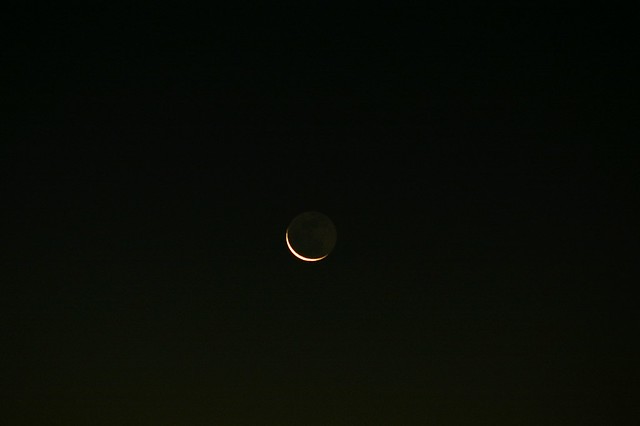
After filling up the van, I drove back up the hill so I could cross Main Street using the light between City Hall and the Library and just happened to look east again. I noticed the colors caused by twilight and pulled into the Library’s parking lot for a second photo shoot. I quickly reset up the camera and took another ten minutes worth of photos before continuing on to Scooters for a warm mocha and a caramel apple scone.
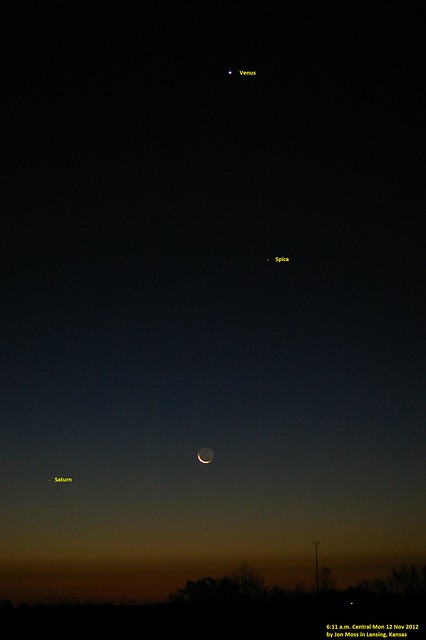
I downloaded the photos from the camera and reviewed them. I threw away most of the first photo shoot because I forget to set the two second delay timer and most of them were blurry. I logged into my Astronomy.com account and downloaded the sky dome for the east-southeastern horizon to confirm and label the objects photographed above.
I had completely forgotten that Saturn had finally come out from behind the sun to become visible once again in the early morning. In fact, Saturn rose just nine minutes after the moon did, although my camera did not capture it in my first photo shoot, probably because it was hiding behind some tree limbs.
I also photographed the Big Dipper, Orion, Canis Major and the Pleiades, but decided not to share the photos with anyone yet. Because I didn’t change from my telephoto lens to my normal one, I did not get all the stars in the handle of the Big Dipper nor did I capture all of the stars in Orion.
I’ll probably miss this weekend’s meteor shower, as I will be otherwise occupied during the day and not in a location that will provided dark enough skies to properly observe a shower. A solar eclipse occurs tomorrow, but only for those excessively lucky people who live in the South Pacific. For more of what’s up this week, visit Astronomy’s the Sky this Week website.
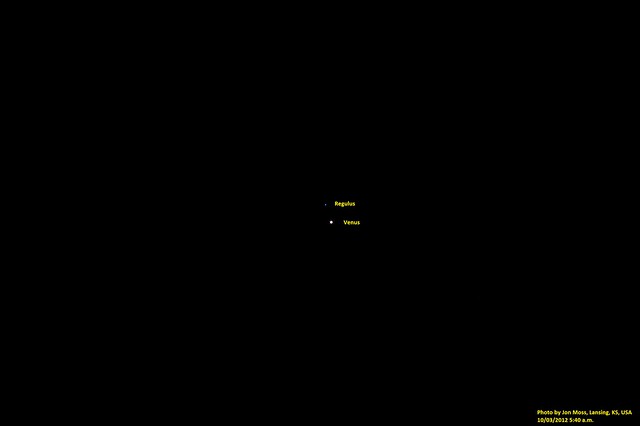
I almost forgot to check the eastern horizon this morning. I hit the off button instead of the snooze button so I started awake around 5:30 a.m. in a near panic for oversleeping. As I rushed around the house getting ready for work, my brain finally dislodged this tidbit I had read via Astronomy.com sometime over the past weekend:
Wednesday, October 3
Venus dominates the morning sky all week after it rises around 3:30 a.m. local daylight time. It shines at magnitude –4.1, which makes it the brightest point of light in the sky, and climbs more than 25° above the eastern horizon an hour before sunrise. Be sure to watch for it this morning, however, because it passes just 7′ (one-quarter of the Full Moon’s diameter) south of Leo the Lion’s brightest star, Regulus. This is the closest any planet approaches a 1st-magnitude star during 2012. A telescope will show both objects in the same field of view. Look closely and you’ll see Venus’ 16″-diameter disk, which appears about 70 percent lit.
I had to re-attach the tripod mount to the bottom of the Pentax camera because I had used it the night before to try my new binoculars with the tripod mount attachment. The waning moon hung just over the roof of my house as I stood in the driveway setting up the tripod and camera. I could see bright Venus with my naked eye (of course, it’s the brightest thing in the sky besides the moon) but I wasn’t sure I could see Regulus without some optical aid.
I peered through the tiny viewfinder in the camera and could clearly see Regulus above Venus. I took several photos, only one of which I liked well enough to label, upload and use in this post (see above). Not many other stars are visible in the photo above, but here’s the sky chart for the eastern horizon from my location as of the date/time the photo was taken:
I did not drag either telescope out of the house and into the driveway. I didn’t have time to re-assembly Dob and the ETX-90 just takes too long to setup, align, configure, etc. I did use my new binoculars, without a tripod, and looked at Venus and Regulus, Sirius, Orion’s Sword, the Pleiades, Jupiter and its moons and our own satellite (although I saved it for last as I became blinded by its light with just a quick look).
With rain forecast for Friday and possibly Saturday, I doubt I’ll be stargazing much this weekend. I may take advantage of the KC Renaissance Festival’s discount on tickets for an inclement weather forecast and the pirate themed weekend events.
Redundant title, but I felt the need to bewitch you by using the word ‘betwixt.’ When I stepped outside this morning, about ninety minutes before sunrise, I looked up and couldn’t believe the incredibly bright stars and planets I could see against a dark sky. Very unusual sight from my front steps. I even called my husband out to look at the gorgeous perfect visibility of the entire constellation Orion. We could even see all seven stars of the Pleaides, directly overhead. I couldn’t resist the siren call of my camera, so I went back inside, grabbed the tripod and the camera and took a half dozen photos.

Yesterday morning, the moon was a bit brighter and closer to Jupiter.
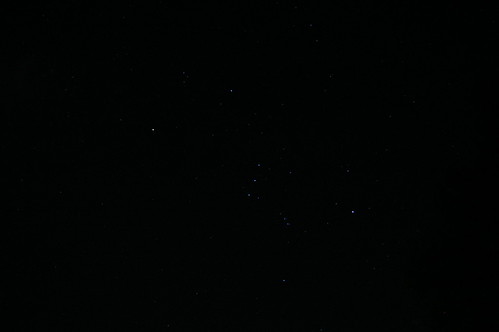

Click on any of the above images to see larger versions of them.
I can’t wait to see what tomorrow morning has in store for me.
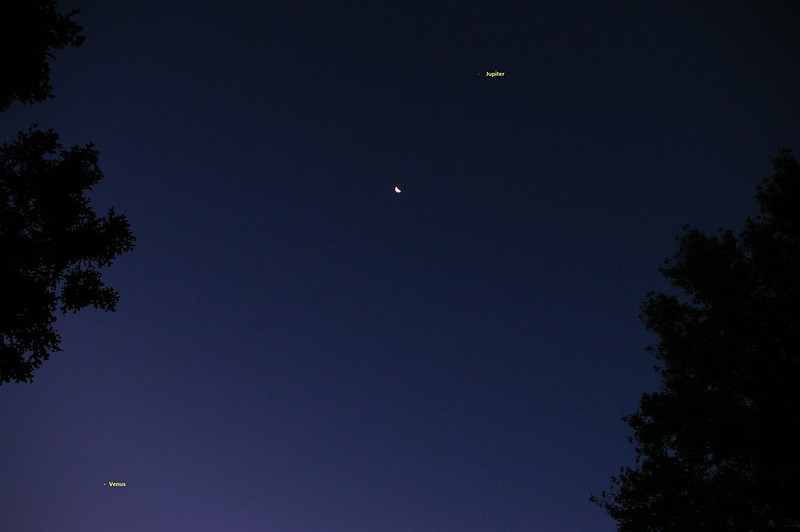
I used the normal lens this morning to capture these three objects in one field of view. I also had to crank the camera back and tip it almost completely vertical, as Jupiter was almost directly overhead.
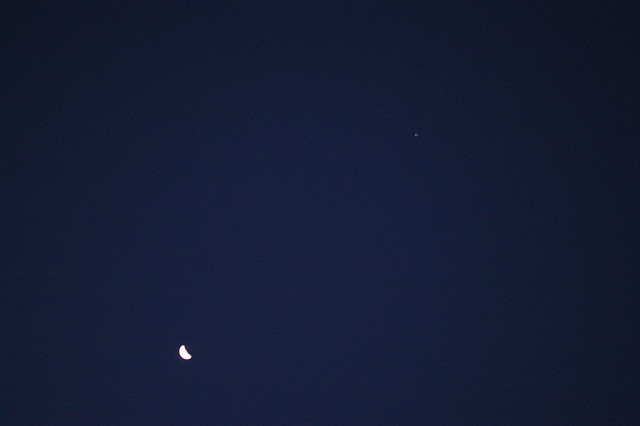
Fairly clear skies, so I didn’t stick around for sunrise.
I rode a rollercoaster of challenges this past weekend. On the high side, my son and daughter-in-law drove up from North Texas for a visit. On the down side, despite the worst drought in recorded history, cloud cover prevented me from observing the Perseid meteor shower Saturday night/Sunday morning and the occultation of Venus by the Moon Monday afternoon. The Ides of August dawned clear this morning, the first time in nearly a week I’ve been able to see the morning planets and waning crescent moon shining brightly above the eastern horizon.
I only hit the snooze on my alarm once, because I stayed up too late with Dob and then decided to watch the latest episode of Warehouse 13 instead of going to bed like I should have. My adventures in the backyard with the XT8 and the Intelliscope handheld computer device determined one of the sensors (probably the altitude one) is not reporting to the device as it should. I’ll have to troubleshoot that situation Thursday evening. I attempted to star hop from Deneb to the North American nebula, but seeing (visibility) proved too poor and I need more practice with the XT8 so I know which direction I’m going (what I see in the eyepiece v. what I see in the finderscope v. what I see on my star atlas).
Before the alarm could buzz a second time, I got up, got dressed, grabbed my purse and left the house. I drove the van a couple of blocks up the hill from my house to the dead end in front of City Hall, where I have a completely unobstructed view of the eastern horizon (I routinely see airplanes take off and land at KCI and can usually see the control tower as well). I retrieved the camera and tripod from the back of the van and had it setup, with the normal lens attached, just shortly after 5:30 a.m. I took a few wide field shots to capture all three planets and the moon.
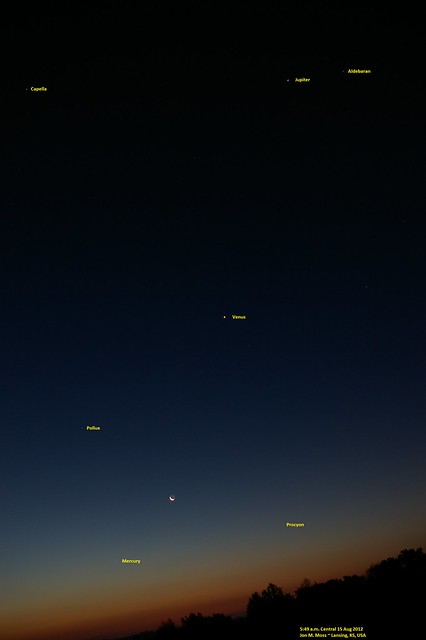
The above photo immediately took me back six months, when I went hunting for Mercury the first time. Last Febriary, I chased after a similar lineup of Jupiter, Venus, the new moon, and Mercury, during the evening hours, looking towards the west. Now, I’m on the flipside, for real. Warm, instead of cold. East, instead of west. Dying moon, instead of newborn moon. Mercury rising, not falling.
I love seeing Orion rising in the east. To me, the Hunter heralds the approaching fall, my absolute favorite season of the year. His two canine pals nipped at his heels (Canis Minor and Canis Major), illustrating we truly are in the ‘Dog Days’ of Summer.
I took a few more shots of all three planets in one frame, then zoomed in on Mercury and the Moon, trying to capture that ellusive earthshine.
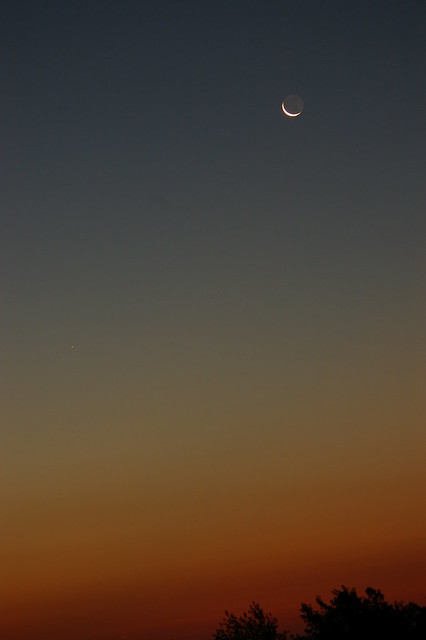
I ended my photo shoot with several closeups of the waning moon, using my telephoto lens. I selected the best of the bunch to upload to Flickr and share here.
Next up for me, astronomically, is hunting for Neptune, which reaches peak brightness (opposition from the sun with us in the middle) on August 24th. I will need to wait until close to midnight Friday to make my first foray, when the other blue planet should be visible from my backyard (between tall trees and houses) in the southern skies, swimming in the constellation Aquarius.
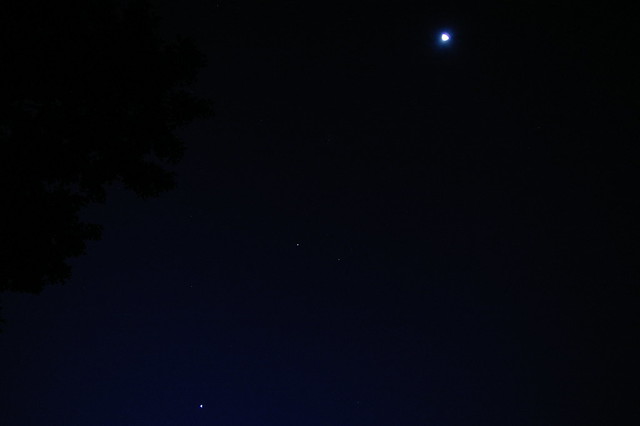
I fell asleep amid visions of rainbows and towering gilded sunsets dancing in my head. I woke up to clear skies this morning. Clear enough that I drug the tripod out and stuck the camera on it for a few minutes during the five o’clock hour before the sun began bleaching the eastern horizon.
Jupiter still hugged close to Aldebaran, but the most surprising sight for me was Orion visible, appearing to be lying down on the eastern horizon. I could see most of the stars in that constellation, but the moon and Venus shone significantly brighter.
As the week wears on, the moon will pass by or through the two planets. I plan to take more early morning photos until the new moon. I am especially looking forward to the opportunity presented Sunday morning, when I may be able to capture Mercury in addition to the objects shown above.
I may be staying up all night Saturday to watch the Perseid meteor shower (if you follow that link to Sky & Telescope‘s web page, you’ll see a beautiful photograph taken by local phenom astronomer Fred Bruenjes, a fellow member of the Astronomical Society of Kansas City). The weather, in addition to being much cooler, may cooperate and keep the skies clear.
I should probably take a nap Saturday or go to bed early, and then get up after midnight and drive somewhere, probably northwest of my home, to a darker sky location. Then, I should be able to see more meteors streaking through the sky, than if I lounged around in my backyard, peering through the local light pollution and leafy tall trees. But I doubt I’ll be able to take a nap, because I am also expecting out-of-town visitors for the weekend.
No rest for the aspiring amateur astronomer.
And not much of it even purple.
I could easily see Venus, Jupiter and Aldebaran throughout the twenty minutes I vanely searched for the rising moon.
But I finally gave up looking for the last vestige of the waning moon with ten minutes left before sunrise.
And just before I took the camera off the tripod, I turned it north to capture some pink and purple tinged clouds.
But alas, I spied no moon amid the sea of haze washing up along the eastern horizon. Not surprising since the Kansas City area is under a heat advisory until Saturday evening (four days from now).
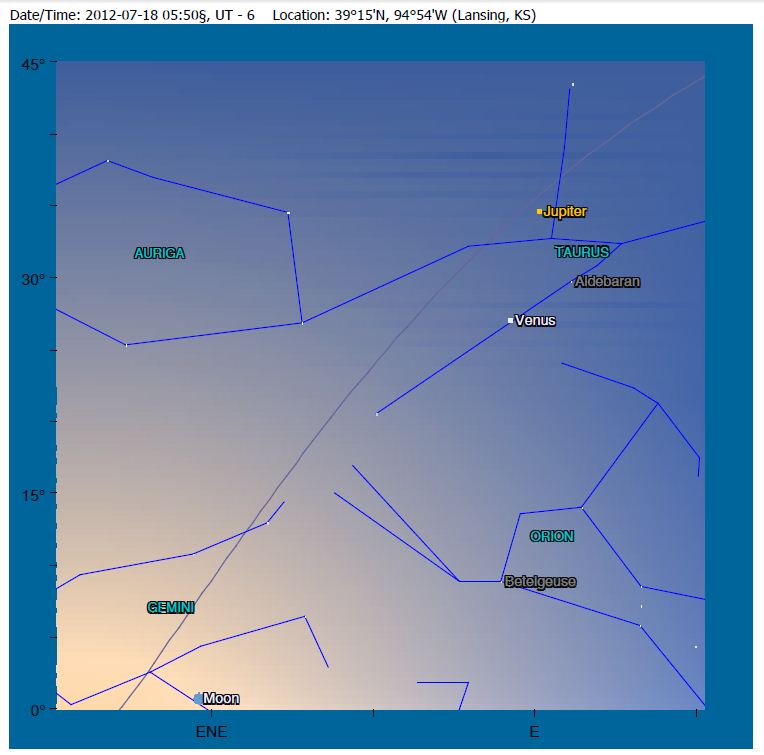 When I checked the star chart for the eastern horizon at moonrise later, I realized the moon wouldn’t even reach the five degree mark above the horizon before the sun rose. From the photos I took yesterday morning, I could discern the haze exceeded that height easily, which made an even thinner, dimmer crescent moon that much more difficult to find. I may have set myself an impossible task considering the amount of humidity in the atmosphere during the summer months in Kansas.
When I checked the star chart for the eastern horizon at moonrise later, I realized the moon wouldn’t even reach the five degree mark above the horizon before the sun rose. From the photos I took yesterday morning, I could discern the haze exceeded that height easily, which made an even thinner, dimmer crescent moon that much more difficult to find. I may have set myself an impossible task considering the amount of humidity in the atmosphere during the summer months in Kansas.
Perhaps I’ll have better luck next month capturing the elusive barest glimmer of the waning crescent moon.
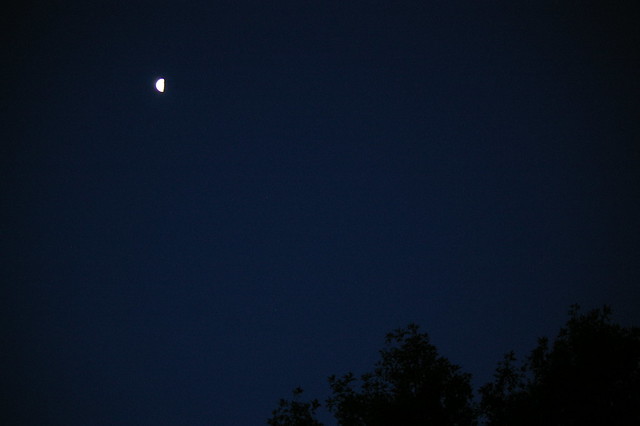
I let Apollo out this morning and looked up (like I always do) and realized the sky was unusually clear, free of haze or clouds. I vaguely remembered reading an astronomy alert on Monday about Jupiter or Venus being less than ten degrees from a bright star (which one I couldn’t remember off the top fo my head). So, I left Apollo in the back yard and traversed the house to the front door on the east side. I stepped outside and had to walk down the steps to get out from under my large black oak tree, which blocks all of the eastern horizon when you look out the front door or windows of my house. Up and to the southeast I easily found the waning moon (see photo above). Turning back to the east, I found a very bright Venus and a somewhat less bright (but not by much) Jupiter directly above it. And just to the lower right of Venus, I could barely see a star twinkling.
I went back in the house and grabbed my camera. The tripod stayed locked in the trunk of the car. I just hoped I could keep steady enough to capture the ‘morning stars’ from the driveway. I took half a dozen shots of Jupiter and Venus and three or four of the waning moon. Then I went inside to review the results.
All but the last photo of Jupiter and Venus were blurry from not using a tripod. Only one photo of the moon, done with some manual fiddling with the shutter and aperture proved to be passably viewable.
I hopped on the Astronomy.com website to access their Star Dome Plus subscriber only star atlas Java application. I needed to determine the name of the star faintly sparkling next to bright Venus. I set the app to look at 45 degrees of the eastern horizon at the time I took the photo (5:35 a.m. Central) and discovered Aldebaran of the constellation Taurus to be the star near our sister planet. Here’s a screenshot of the eastern horizon courtesy of Star Dome Plus:

I quickly edited my one good photo of the ‘morning stars’, rotating the orentation from landscape to portrait and adding some text labels to identify the objects observed. Here are both the unlabelled and labelled versions of that photo:
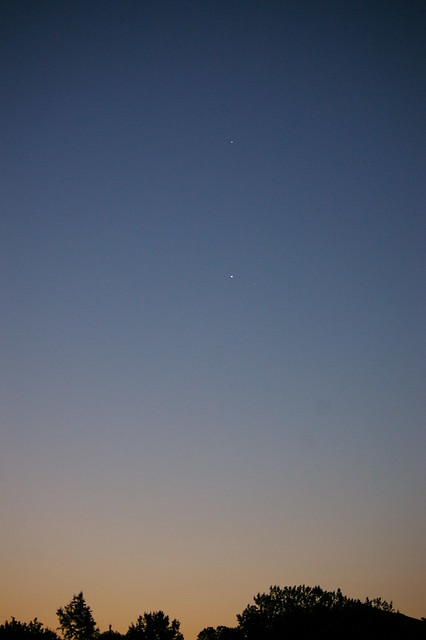
I did remember to let Apollo back in from his morning soujourn through the backyard. He turned his nose up at his breakfast and climbed up on the couch for his morning nap.